Llanwrtyd Wells is a small town in Breconshire, situated on the Afon Irfon, astride the A483 between Llandovery and Builth Wells. The town grew as a spa town around the Ffynon Ddrewllys during the 19th century and has also been the location for the eisteddfod and for the World Bog Snorkelling Championships. The largest employer in the town was the Cambrian Woollen Mill, which is now a tourist attraction. The men of the town who fell during both World Wars are commemorated on war memorial tablets which are situated within the Llanwrtyd Wells War Memorial Institute. The building was opened on 1 November 1928. The building has since been used as a Police Station and more recently by the town council.
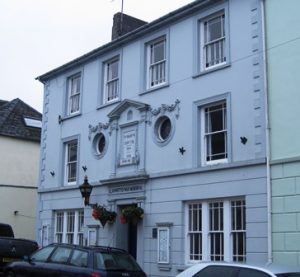
The Great War, 1914-1918
Glyn Blythe, Lance Corporal, 3/8096, Dorsetshire Regiment. Glyn was the son of George Blythe and Sarah Ann Blythe (nee Campion), of Esgairmoel, Llanwrtyd Wells. He was lodging at Cwmcyttan, Cynghordy by 1911, where he worked as a builder. Glyn enlisted into the 3rd Battalion, Dorsetshire Regiment at Merthyr Tydfil soon after the outbreak of war and was posted to Weymouth for training. On 8 April 1915 he was drafted to France, joining the 1st Battalion, Dorsetshire Regiment, which was attached to 15 Brigade, 5th Division, and joined the battalion at Ypres. Glyn saw his first major action during the Second Battle of Ypres, which opened following a German gas attack, the first of the war, at Gravenstafel on 22 April and raged until 25 May 1915. The 5th Division left Ypres at the end of July and entrained for the Somme sector, taking over positions at Bois Francais. On 31 December 1915 the 1st Dorset’s left the 5th Division to join 95 Brigade of the newly arrived 32nd Division. A week later the brigade became renumbered as 14 Brigade, in the same 32nd Division. The Division took over a section of the Somme line near Authille, where it remained over the coming months until taking part in the opening phase of the Battle of the Somme on 1 July 1916. The Division remained on the Somme throughout the following months, taking part in further major actions, especially during the latter stages at the Battle of the Ancre and the resulting Operations on the Ancre. It remained in the Somme sector over the winter, and in March 1917 followed the German Retreat to the Hindenburg Line. The Division took over positions in the Holnon sector over the coming months. Glyn was accidentally wounded whilst the battalion was training behind the lines at Lanchy in May 1917 and died of his wounds on 14 May 1917. The 20-year-old is buried in Nesle Communal Cemetery, some 20km south of Péronne, France.
John Caleb Brick, Private, 14519, Kings Shropshire Light Infantry. John was the son of Aaron Brick and Margaret Brick (nee Davies), of Providence Place, Llanwrtyd Wells. He worked as a colliery labourer at Ammanford prior to the war. John travelled to Llandrindod Wells to enlist into the 7th Battalion, King’s Shropshire Light Infantry soon after the outbreak of war. The battalion formed at Shrewsbury before moving to Codford, Salisbury Plain, joining 67 Brigade, 25th Division, before moving into billets at Bournemouth. The Division moved to Romsey in May, then Aldershot the following month, before embarking for France and landed at Boulogne on 28 September 1915, before moving to positions near Ploegsteert Wood. Two weeks later the 7th KSLI transferred to 8 Brigade, 3rd Division. The Division was at Ypres at the beginning of 1916, and the 7th KSLI saw its first major action at the Bluff and the St. Eloi craters, following the blowing of two underground mines by the Germans. On 1 July 1916 the Division left the Ypres Salient and began to move south to the Somme, to join the great Somme offensive. The Division reached the ruins of Carnoy by 7 July and the battalions reconnoitred the line prior to moving forward into the trenches the following day. During the morning of 14 July 1916, the Division launched its first assault on the Somme, with 8 Brigade launching an attack against Bazentin-le-Grand. The assault failed due to uncut barbed wire holding up the men in No Man’s Land and the survivors were forced to withdraw. John was killed in action during the fighting that day. The 32-year-old has no known grave and is commemorated on the Thiepval Memorial, France.
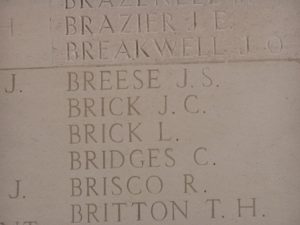
David John Davies, Gunner, 166472, Royal Garrison Artillery. David was born on 26 December 1889, the son of John Alfred Davies and Margaret Ann Davies (nee Jones), of Bryn Irfon, Llanwrtyd Wells. He worked as a blacksmith prior to the war. David had enlisted into the Montgomeryshire Yeomanry on 26 April 1909 and served as a Shoeing Smith with the regiment, which was a Territorial Army unit. He attended the annual TA summer camps at Llandovery, Newtown, Builth Wells and Llandeilo over the coming years. On 5 August 1914 the Montgomeryshire Yeomanry was mobilised at Welshpool, as part of the South Wales Mounted Brigade, before moving via Hereford to Thetford, to join the 1st Mounted Division. On 26 April 1916 David was discharged from the Montgomeryshire Yeomanry, having completed seven years’ service, then re-enlisted into the Royal Garrison Artillery. He was posted to France and joined the 34th Siege Battery, RGA, which was in the Ypres Salient. David was killed in action at Ypres on 15 September 1917, probably by German counter-battery fire. The 27-year-old is buried in Voormezeele Enclosures No.1 And No.2, Belgium.
Elizabeth Davies, Nurse, Red Cross. Elizabeth was the daughter of Councillor Llewellyn Davies and Harriett Davies, of Bryngelly House, Landore, Swansea. Following the outbreak of war she volunteered for the Red Cross and was posted to the YMCA Red Cross Hospital at Llanwrtyd Hall, Llanwrtyd Wells. Elizabeth served throughout the duration of the war, becoming Quartermaster of the Hospital and remained in the hospital after the Armistice. She died there on 9 July 1919, aged 56. Her remains were brought home to Swansea and she was buried in Cwmgelly Cemetery, Swansea, with the flag of the Red Cross draping her coffin. Elizabeth is not commemorated by the CWGC and she is not commemorated on the Llanwrtyd Wells war memorial.
Isaac Davies, Private, 54784, Royal Welsh Fusiliers. Isaac was born at Llanwrtyd Wells in 1886, the son of James Davies and Anne Davies. By 1901 the family had moved to 28, Worcester Street, Brynmawr, where James had found work as a haulier. Isaac worked as a Grocer’s Assistant prior to the war. He enlisted into the Glamorganshire Yeomanry at Tonypandy and after completing his training was transferred to the Royal Welsh Fusiliers. Isaac was drafted to France in the autumn of 1916, joining the 15th Battalion, Royal Welsh Fusiliers, which was at Ypres, holding the Canal Bank sector at Boesinghe, attached to 113 Brigade, 38th (Welsh) Division. The Division had moved there following its epic assault on Mametz Wood in July. Upon its arrival the infantry battalions of the Division then began carrying out the normal pattern of rotation in the trenches, four days in the front, four in support and four in reserve, whilst also working on trench improvement, digging new trenches, and also carrying out regular patrols and trench raids. During the summer of 1917 the Division began training and preparing to take part in the opening offensive of the forthcoming Third Battle of Ypres, or Passchendaele, tasked with the capture of Pilckem Ridge. By 23 July the 15th RWF had completed its training behind the lines and moved back into the front-line at the Canal Bank, to begin its final tour in the line before the attack. Reports then reached battalion HQ that the Germans had withdrawn, so at dawn on 25 July 1917 the battalion sent out a raiding party to verify the intelligence. Unfortunately, the Germans were still in position and the raiding party came under heavy machine-gun fire. Isaac was killed in action that day. The 31-year-old has no known grave and is commemorated on the Ypres (Menin Gate) Memorial, Belgium. Isaac is not commemorated on the Llanwrtyd Wells war memorial.
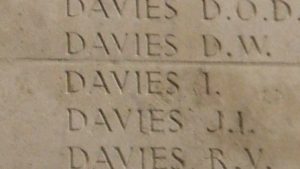
Thomas Davies, MM, Lieutenant, Machine Gun Corps. Thomas was the son of Rees Davies and Elizabeth Davies, of Gellyfelen Farm, Llanwrtyd Wells. He was hit in the chest by a bullet during the opening assault of the Somme offensive on 1 July 1916, but was saved by his pocket bible, which contained the bullet, leaving just bruising to his chest. Thomas was awarded a Distinguished Service Certificate and later the Military Medal in December 1916, prior to being commissioned as Second Lieutenant into the Machine Gun Corps in May 1917. Thomas was seriously wounded in the summer of 1918 but survived and returned home. He appears to have died in 1922, aged 32. Nothing further is known of him, as he is not commemorated by the CWGC.
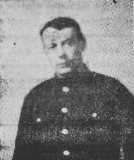
William James Davies, Gunner, Royal Field Artillery. William was the son of David and Margaret Davies, of 1, Tylosg, Llanwrtyd Wells. He worked as a farm labourer at Caeraw, Llandulas prior to the war. Nothing more is known of William, who appears to have died after the war.
William Evans, Private. Nothing further is known of William, who appears to have died after the war.
John James Griffiths, Private, 17863, Welsh Regiment. John was the son of Alfred and Laura Griffiths, of Maes Ddu Cottage, Llanrhos. He was working at Swansea when war was declared and enlisted there into the 14th Battalion, Welsh Regiment on 14 November 1914. The battalion was raised as the Swansea Pals battalion and moved to Colwyn Bay, joining 129 Brigade, 43rd (Welsh) Division. After completing its training the entire Division moved to Salisbury Plain in the summer of 1915, where it was renumbered to the 38th (Welsh) Division. The Division moved to France on 2 December 1915 and moved to the Nursery Sector near Fleurbaix for trench initiation alongside the Guards Division. The Division then held a sector of the line near Cuinchy before marching south to the Somme sector in June 1916 to take part in the assault on Mametz Wood. The first attack on the wood was launched on a two-battalion front on 7 July, but failed, and the Divisional Commander, Sir Ivor Philipps, was replaced before the Division attacked again on a two Brigade front on 10 July 1916. After two days of ferocious hand-to-hand fighting, the wood was cleared up to its northern edge, before the battered Division was relieved. By now John’s health was suffering. He was discharged from the army on 27 July 1916 due to sickness and returned home to Swansea. He married Irene Jane Rees in 1917 and the couple moved to 1, Station Road, Llanwrtyd Wells. John’s health continued to wane over the coming years, and he died of tuberculosis at Llanwrtyd Wells on 25 November 1922, aged 28. Nothing further is known of him as he is not commemorated by the CWGC. John is not commemorated on the Llanwrtyd Wells war memorial.
David John Jones, Private, 18809, New Zealand Expeditionary Force. David was born at Cilycwm, Carmarthenshire on 2 July 1879, the son of David Jones and Margaret Jones. His father worked as a railway platelayer and by 1886 had moved the family to Sugar Loaf Cottage, Llanwrtyd Wells. David had emigrated to New Zealand as a young man and found work as a warehouseman in Auckland. He enlisted into the New Zealand Expeditionary Force at Trentham on 5 April 1916 and was posted to the 15th Reinforcements for the Auckland Regiment. He embarked for England at Auckland on 25 July 1916 and disembarked in England on 4 October. Just three weeks later, David was drafted to France, landing on 22 October before joining the 2nd Battalion, Auckland Regiment. The battalion was attached to the 2nd New Zealand Brigade, New Zealand Division and was attached to the II Anzac Corps. The Division moved to Flanders from the Somme in February 1917, initially to billets in Steenwerck. David was posted as missing whilst the 2nd Auckland Regiment was holding the trenches here on 21 February 1917. The 37-year-old was later found to have been killed in action on that date. His body was later recovered together with several other New Zealand graves on the battlefield during the post-war battlefield clearances and was identified by his identity papers which had been stuffed into a bottle with his body. David was re-interred in Pont-du-Hem Military Cemetery, La Gorgue, France on 13 October 1923, together with his fellow New Zealand servicemen.
Evan James Jones, Private, 39775, Machine Gun Corps. Evan was the son of Mary Anne Jones, of Ffosyffynnon, Llanwrtyd Wells. He worked for William Williams, of Myrtle House prior to the war. Evan enlisted at Llandovery into the 3rd Battalion, Welsh Regiment, joining the battalion at the Barracks at Cardiff. Evan was then transferred to the Machine Gun Corps at Grantham. He came home on leave in January 1916, then returned to Grantham, where he sadly took ill and died of pneumonia on 12 February 1916. The remains of the 19-year-old were conveyed home and he was buried with full military honours in Cefn Gorwydd (Gosen) Calvinist Methodist Churchyard.
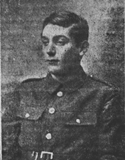
Evan Owen Jones, Sergeant, 33619, Welsh Regiment. Evan was the son of William Jones and Margaret Jones, of 1, Chapel Street, Llanwrtyd Wells. He lived at the Abernant Hotel prior to enlisting into the Welsh Regiment on 11 December 1915. Evan was drafted to one of the battalions of the Welsh Regiment in France in the summer of 1916 as he returned home wounded in the autumn of that year. Upon his return to France he was posted to the Labour Corps, and was wounded again in March 1918, probably during the German Spring offensive, returning home on sick leave before returning to France once more. Evan survived the war, coming home on leave again in November 1918, before being discharged from the army as medically unfit on 22 February 1919. He was later hospitalised in Cardiff, where he died of heart disease, brought about by the strains of military service, on 28 December 1919. The 29-year-old was buried in St. David’s Churchyard, Llanwrtyd Wells. Evan is not commemorated by the CWGC.
Stewart Woosnam Jones, Corporal, 235972, Herefordshire Regiment. Stewart was born in Barnsbury, Herefordshire in 1896, the son of PC William Woosnam Jones and Mary Jones (nee Barker). The family came to live at Pleasant View, Llanwrtyd Wells, when William was posted to Llanwrtyd Wells Police Station. Stewart enlisted into the Herefordshire Regiment soon after the outbreak of war and served with the regiment at Gallipoli, where it served with the 53rd (Welsh) Division. He contracted enteric fever and was evacuated off the peninsula before returning to Britain. Stewart then returned home on sick leave before being transferred to the 11th Battalion, Cheshire Regiment. He was wounded in France soon afterwards and upon his recovery was posted to East Africa as a drill instructor in 1918. Stewart returned to Britain after the war, but his health was failing. He died at Llanwrtyd Wells on 12 March 1923. The 27-year-old was buried in St. David’s Churchyard, Llanwrtyd Wells. Stewart is not commemorated by the CWGC.
Aneurin Rhys Lewis, Gunner, 124040, Royal Garrison Artillery. Aneurin was the son of Charles William Rhys Lewis and Miriam Lewis, of Fronfelen, Llandovery. He lived at Erewbeili, Llanwrtyd Wells prior to the war, and worked as a farmer. Aneurin enlisted at Oxford into the Royal Fusiliers on 26 October 1916, but was discharged as unfit, and re-enlisted into the Royal Garrison Artillery. Aneurin returned home to Llanwrtyd Wells on leave in January 1917 before being posted to France, joining the 13th Siege Battery, Royal Garrison Artillery. Aneurin was killed in action when his battery came under fire during the opening day of the German Spring Offensive on 21 March 1918. The 20-year-old was initially buried on the battlefield, but in 1920 his body was exhumed, and he was re-interred in Gouzeaucourt New British Cemetery, France.
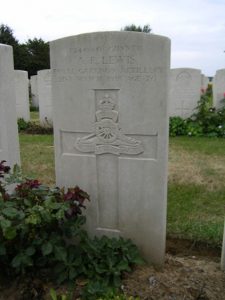
John Nicholas Lewis, Lieutenant, Welsh Regiment. John was born in Islington, the son of Jonah and Mary Lewis. The family later resided at Ffynonau, Llanwrtyd Wells, Breconshire. John was educated at Llandovery from 1903 until 1905, before entering St. John’s, Oxford. He enlisted into the Army in 1914, and was commissioned into the 8th Battalion, Welsh Regiment. The Battalion was attached to 40 Brigade, 13th (Western) Division, and on 4 August 1915 sailed from Lemnos, arriving at Anzac Cove, Gallipoli on 6 August 1915. From Anzac they marched to Chailak Dere, where, with the 7th Gloucester’s, they were in support of the New Zealanders of the Wellington Regiment and the Auckland Mounted Rifles. On 8 August 1915 an attempt was made to capture the heights at Chunuk Bair, and some men of the 8th Welsh were among the handful of troops who reached and held the peak for a few hours. However, the Battalion was cut to pieces while crossing Apex Ridge. John was in charge of a platoon of Bomb throwers who charged the crest and succeeded in reaching the other side. They came under fire from Hill Q, which should have been cleared, and John was hit in the arms, chest and leg by rifle and machine gun fire. He fell into a gully, and his servant ran to help him, but found him severely wounded. While being bandaged, he asked for a match to light his cigarette, and handed his pocket watch to his corporal for safe keeping. When asked if there was anything else that could be done for him, he is reported to have said “No, lads, I am done for, but go on lads, and do your duty, for there is one above who will take care of us”. Some days later, Lt Wynne Jones took out a party of stretcher bearers to see if they could find John, but they were unable to reach the gully due to heavy Turkish fire, and his body was never recovered. The 22-year-old has no known grave and is commemorated on the Helles Memorial, Gallipoli.
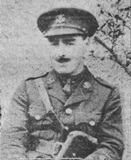
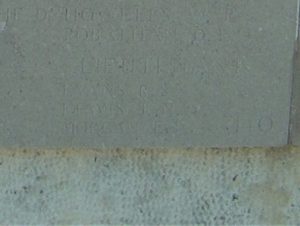
Arthur Evan Preece, Sapper, 88473, Royal Engineers. Arthur was born at Knighton in 1879, the son of Thomas Preece and Harriett Preece. He married a widow, Alice Williams (nee Davies), in 1907 and the couple lived at Clarence House, Llanwrtyd Wells. Arthur worked as a railway platelayer for the North Western Railway at Llangammarch Wells prior to the war and after enlisting at London into the Royal Engineers, was posted to the 115th Railway Company, Royal Engineers. He embarked for France with the Company on 3 September 1915 and entrained for Marseilles, before embarking again for Egypt. Arthur was killed in action in Egypt, probably during a melee with Senussi tribesmen, on 4 December 1916. The 37-year-old is buried in Kantara War Memorial Cemetery, Egypt.
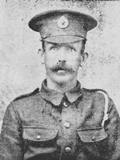
Gwilym Thomas Richards, Corporal, 22259, Royal Welsh Fusiliers. Gwilym, or William, was the son of Edward Richards and Kate Richards, of Wellington House, Llanwrtyd Wells. He was working in London when war broke out and enlisted at Holborn into the 15th Battalion, Royal Welsh Fusiliers, the London Welsh battalion. The battalion moved to Llandudno on 5 December 1914, joining 128 Brigade, 43rd (Welsh) Division and trained in North Wales before moving to Winchester in the summer of 1915, where the formation became renumbered 113 Brigade, 38th (Welsh) Division. Gwilym then transferred to the 14th Battalion, Royal Welsh Fusiliers, which was in the same Brigade. The Division moved to France on 2 December 1915 and moved to the Nursery Sector near Fleurbaix for trench initiation alongside the Guards Division. The Division then held a sector of the line near Cuinchy before marching south to the Somme sector in June 1916 to take part in the assault on Mametz Wood. The first attack on the wood was launched on a two-battalion front on 7 July, but failed, and the Divisional Commander, Sir Ivor Philipps, was replaced before the Division attacked again on a two Brigade front on 10 July 1916. After two days of ferocious hand-to-hand fighting, the wood was cleared up to its northern edge, before the battered Division was relieved. It then took over a section of the front at Hébuterne before moving to the Ypres Salient and taking over the Canal Bank sector at Boesinghe. The infantry battalions of the Division then began carrying out the normal pattern of rotation in the trenches, four days in the front, four in support and four in reserve, whilst also working on trench improvement, digging new trenches, and carrying out regular patrols and trench raids. As the summer of 1917 dawned, the units of the 38th (Welsh) Division began taking turns out of the line, carrying out specialist training for the forthcoming Third Battle of Ypres, where the Division had been tasked with the capture of Pilckem Ridge. The 14th RWF had completed its training by 20 July and moved back to the battle zone, taking over support positions behind the Canal Bank and two days later relieved the 16th RWF in the front line. Gwilym was killed in action during a German artillery bombardment which hit the battalion on 24 July 1917. The 31-year-old is buried in Bard Cottage Cemetery, Belgium.
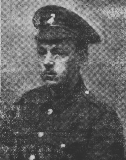
Evan Thomas, Private, 5197, Welsh Regiment. Evan was the son of William and Margaret Thomas, of Llwynheilog, Llanwrtyd Wells. He resided at Burry Port prior to the war but returned home to enlist at Llanwrtyd Wells into the Pembrokeshire Yeomanry. Evan was posted to Norfolk to join the 3/1st Battalion, Pembrokeshire Yeomanry, and was then posted to Dublin with the battalion. He saw service during the Easter Riots of 1916, before returning home on leave in July 1916. Evan embarked for France in August, where he was transferred to the 13th Battalion, Welsh Regiment, which was attached to 114 Brigade, 38th (Welsh) Division. The battalion was rebuilding following heavy losses at Mametz Wood in July. It then took over a section of the front at Hébuterne before moving to the Ypres Salient and taking over the Canal Bank sector at Boesinghe. The infantry battalions of the Division then began carrying out the normal pattern of rotation in the trenches, four days in the front, four in support and four in reserve, whilst also working on trench improvement, digging new trenches, and carrying out regular patrols and trench raids. On 5 September 1916 the 13th Welsh relieved the 11th SWB in the right sector of the Divisions new line, to begin a routine tour and began work on improving the trenches. Evan was wounded during this spell in the line and died of his wounds on 10 September 1916. The 24-year-old is buried in Ferme-Olivier Cemetery, Belgium.
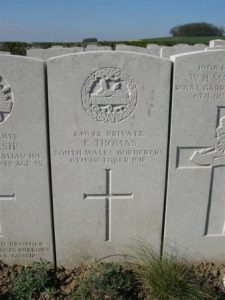
Peter Roderick Williams, Lance Corporal, 22895, Royal Welsh Fusiliers. Peter was the son of Roderick Williams and Sarah Williams (nee Jones), of 10, Irfon Terrace, Llanwrtyd Wells. He ran his own hairdresser’s business from home prior to the war. Peter enlisted into the 15th Battalion, Royal Welsh Fusiliers, the London Welsh battalion, soon after the outbreak of war and was posted to D Company. The battalion moved to Llandudno on 5 December 1914, joining 128 Brigade, 43rd (Welsh) Division and trained in North Wales before moving to Winchester in the summer of 1915, where the formation became renumbered 113 Brigade, 38th (Welsh) Division. Gwilym then transferred to the 14th Battalion, Royal Welsh Fusiliers, which was in the same Brigade. The Division moved to France on 2 December 1915 and moved to the Nursery Sector near Fleurbaix for trench initiation alongside the Guards Division. The Division then held a sector of the line near Cuinchy before marching south to the Somme sector in June 1916 to take part in the assault on Mametz Wood. The first attack on the wood was launched on a two-battalion front on 7 July, but failed, and the Divisional Commander, Sir Ivor Philipps, was replaced before the Division attacked again on a two Brigade front on 10 July 1916. Peter was killed in action during the terrible fighting that day. The body of the 23-year-old was found within the wood by men of the 113th Labour Company soon afterwards and he was buried in Flatiron Copse Cemetery, Mametz, France on 20 July 1916.
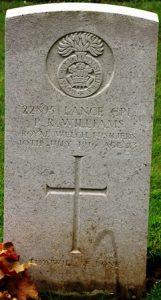
World War Two, 1939-1945
John Rees Davies, Aircraftman 2nd Class, 1447632, Royal Air Force Volunteer Reserve. John was the son of Alfred William Davies and Elizabeth Davies, of Newbridge Bungalow, Llanwrtyd Wells. He enlisted into the Royal Air Force Volunteer Reserve soon after the outbreak of war. John became ill after almost three years in the service and was discharged from RAF and sent to the North Wales Sanatorium at Denbigh. He died there of tuberculosis on 19 December 1942. The body of the 21-year-old was brought home and he was buried in St. David’s Churchyard, Llanwrtyd Wells on 23 December.
William Thomas Glyn Davies, Driver, T/293134, Royal Army Service Corps. William was the son of Theodore Ernest Corbett Davies and Janet Davies (nee Evans), of Ashley Villa, Llanwrtyd Wells. He enlisted into the Royal Army Service Corps and was posted to North Africa. Following the surrender of Rommel’s Afrika Korps on 13 May 1943, the Allies turned their attention towards liberating Italy and the first phase of the campaign was the landings on Sicily on 10 July 1943. Following the liberation of Sicily the Allies began landings on mainland Italy from 3 September 1943 and a long and arduous campaign followed. William died in Italy on 19 June 1945. The 23-year-old is buried in Udine War Cemetery, Italy.
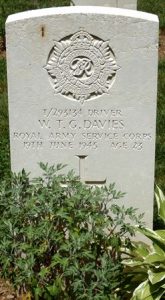
Brinley Morgan Evans, Flight Sergeant, 908598, Royal Air Force Volunteer Reserve. Brinley was born at Llanwrtyd Wells in 1924, the son of Reverend David Cynan Evans and Elizabeth Evans. His father spent much of his life Ministering in the USA and following the outbreak of war the family emigrated to Harvey, Illinois. Brinley was educated at Builth Wells County School. He enlisted into the Royal Air Force Volunteer Reserve as soon as he turned 18 and after training as a Wireless Operator/ Air Gunner was posted to 99 Squadron, Royal Air Force. The squadron was the first unit to be equipped with Vickers Wellingtons, just before the start of the war and flew its first operational mission on the night of 8/9 September 1939. The Squadron then moved to RAF Waterbeach, in Cambridgeshire, where operations began in earnest. On 21 April 1941 Brinley took off from Newmarket aboard Vickers Wellington IC, Serial T2997, which was part of a large bomber force despatched to hit targets in Cologne. Whilst the aircraft was returning home from the raid it struck the tethering cable of a barrage balloon over Harwich, burst into flames and crashed, killing all six of her crew. Brinley was 19 years old when he was killed that night. He has no known grave and is commemorated on the Runnymede Memorial, Surrey.
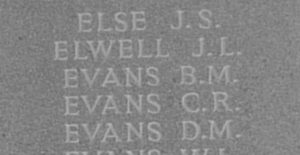
John Isaac Griffiths, Writer, D/MX 72620, Royal Navy. John was born on 7 October 1916, the son of David Timothy Griffiths and Margaret Ann Griffiths, of Myrtle House, Llanwrtyd Wells. He worked as a Bank Clerk at Connah’s Quay prior to the war. John enlisted into the Royal Navy soon after the outbreak of war and was posted aboard the battlecruiser HMS Repulse. The ship had originally seen service during the Great War but had been substantially upgraded and refitted during the inter-war years. At the beginning of the Second World War, Repulse was part of the Battlecruiser Squadron of the Home Fleet, carrying out patrols in the North Sea. Repulse escorted the convoy bringing the 1st Canadian Division to Britain in December 1939, before escorting the aircraft carrier Ark Royal on a search for German shipping around Spain. She was then assigned to the Norwegian Campaign in April 1940, before returning to the North Atlantic and took part in searches for several German capital ships, including the Bismarck before being transferred to East Indies Command. Towards the end of 1941, Winston Churchill sent a small group of fast capital ships, along with one aircraft carrier to Singapore, following the rise of Japanese presence in the Pacific area. HMS Repulse, together with HMS Prince of Wales set off with their destroyer escort in a group named Force Z and arrived in Singapore on 2 December 1941. On the evening of 8 December, Force Z left Singapore to attack Japanese shipping. The ships were spotted by a Japanese submarine on 9 December and a force of Japanese carrier-based dive bombers were despatched to attack Force Z. The attack began on the following morning, 10 December 1941 and tragically resulted in the sinking of both HMS Repulse and HMS Prince of Wales, with huge loss of life. John was just 19 years old when he was killed aboard Repulse that morning. He has no known grave and is commemorated on the Plymouth Naval Memorial, Devon.
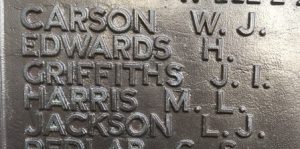
William Evans Herbert, Lance Corporal, 4031578, Durham Light Infantry. William was the son of John Herbert and Annie Maud Herbert (nee Almond) of the School House, Llanwrtyd Wells. William enlisted into the King’s Shropshire Light Infantry soon after the outbreak of war, but was later transferred to the 8th Battalion, Durham Light Infantry. The battalion was attached to the 50th (Northumbrian) Division and had been in France with the BEF at the outbreak of war, taking part in the withdrawal to Dunkirk before being evacuated in May 1940. The Division was sent to the Middle east in June 1941 and at the end of the month deployed to Cyprus. It was then moved to Palestine in November and then to Iraq, to guard against a possible German incursion. In February 1942 the 50th Division was recalled to the Western Desert, joining the Eighth Army on the Gazala line. The 8th DLI began operating against German convoys before getting caught up in heavy fighting following Rommel’s attack on Gazala on 27 May. The 7th and 8th DLI were forced to break through the Italian and German lines before moving east to the safety of Egypt and then took up positions around Mersa Matruh, where it beat off several German attacks. By the time the Battle of Gazala had ended, the 50th Division had lost some 8,000 men. The 50th Division returned to the front line on 4 September, in reserve for the Second Battle of El Alamein, then joined the 2nd New Zealand Division for Operation Supercharge. William was killed during this period, on 2 November 1942. The 29-year-old was originally buried on the battlefield, but his grave was exhumed some months afterwards and he was buried in El Alamein War Cemetery, Egypt on 9 April 1943.
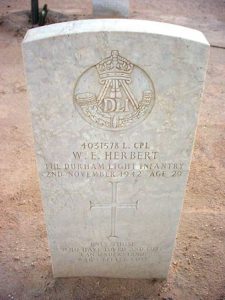
Colin Alfred Kidd, Flight Lieutenant, 42952, Royal Air Force. Colin was born at Crickhowell on 4 November 1913, the son of Lewis James Kidd and Elizabeth Jane Kidd (nee Morgan). The family came to live at Llanwrtyd Wells soon afterwards, but by 1939 had moved to Bristol. Colin married Irene Florence Seagrieff in London in the autumn of 1939. Colin had enlisted into the Royal Air Force prior to the war and trained as an Air Gunner. He was promoted from Sergeant to Pilot Officer on 17 January 1940, to Flying Officer on 17 January 1941 and to Flight Lieutenant on 17 January 1942. Colin served with 156 Squadron, Royal Air Force, which was an elite Pathfinder Squadron, attached to 8 Group, Bomber Command and was based at RAF Upwood, in Huntingdonshire. On the night of 27 April 1944 Colin took off from Upwood aboard Avro Lancaster III, Serial ND409, which was part of a large force of over 300 aircraft despatched to bomb strategic targets in Friedrichshafen. The Lancaster was shot down by a German night-fighter and crashed into woods near Neuhausen on the following morning, 28 April 1944, killing all her crew. Colin was 30-years-old when he was killed in the crash that morning. He was originally buried beside his fellow crewmen in Liptingen Cemetery, but in October 1948 their graves were exhumed and the seven men were re-interred in Durnbach War Cemetery, Germany.
Godfrey Morgan Morris, Private, VX31478, Australian Infantry. Godfrey was born on 28 August 1901, the son of Joseph Peregrine Morris and Mary Morris (nee Hill) of 4, Belle Vue Terrace, Llanwrtyd Wells. He emigrated to Australia on 4 May 1922. Godfrey enlisted at Melbourne into the Australian Imperial Force in June 1940 and was posted to the 2/21st Battalion, Australian Infantry. The battalion was formed on 11 July 1940, as part of the 23rd Brigade, 8th Australian Division. The 8th Division was deployed to Malaya in the Spring of 1941, but 23rd Brigade remained in Australia, to be kept ready for deployment to the islands to Australia’s immediate north: Ambon, Timor and Rabaul, if war broke out with the Japanese. The 2/21st Battalion arrived at Darwin on 9 April 1941 and helped garrison the port over the coming months. Following the Japanese invasion of Malaya on 8 December the battalion was deployed to Ambon, landing on 17 December as part of Gull Force, to reinforce the Dutch garrison on the island. On the evening of 30/31 January 1942 the Japanese began landing on Ambon and by the afternoon of 31 January the Dutch had surrendered. The 2/21st battalion was driven back to the east of the island, where some 150 men were captured and many others killed by the Japanese during heavy fighting. The survivors of the battalion surrendered on 3 February 1941 and were taken to the barracks at Tan Tui where they were incarcerated for the rest of the war, in appalling conditions. Godfrey died of sickness at Ambon on 11 June 1945, just two months before the end of the Pacific War. The 43-year-old was originally buried in Ambon Cemetery No. 2, but after the war his grave was exhumed and he was re-interred in Ambon War Cemetery, Indonesia. His brother, Reverend Ivor Joseph Morris, was killed in North Africa in 1942.
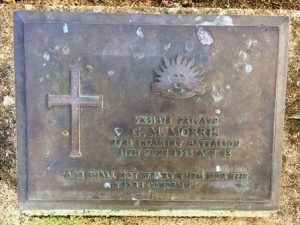
Reverend Ivor Joseph Morris, B.A., Chaplain 4th Class, 157811, Royal Army Chaplains’ Department. Ivor was born on 25 April 1909, the son of Joseph Peregrine Morris and Mary Morris (nee Hill) of 4, Belle Vue Terrace, Llanwrtyd Wells. He studied for his Batchelor of Arts at Lampeter university prior to becoming a Reverend at Cardiff. Ivor was commissioned as a Chaplain 4th Class with the Royal Army Chaplains’ Department in January 1941. He was then posted to the 1st Battalion, Rifle Brigade. The battalion had been in France with the BEF in 1940 and took part in the defence of Calais and was annihilated. It was rebuilt in England before embarking for North Africa with the 1st Armoured Division, seeing several actions before being transferred to the 22nd Armoured Brigade, 7th Armoured Division in June 1942. The battalion saw heavy fighting during the Battle of Alam el Halfa on 31 August 1942 and subsequently took part in the Second Battle of El Alamein. Ivor was killed during the 7th Armoured Brigade’s drive through North Africa on 26 October 1942. The 30-year-old was originally buried at Alameltritriya, but in May 1943 his grave was exhumed and he was re-interred in El Alamein War Cemetery, Egypt. His brother, Godfrey Morgan Morris, died as a Japanese prisoner of war in 1945.
John Penry Williams, Chief Steward, Merchant Navy. John was born at Red Cow, Hendy on 5 May 1893, the son of Roderick Williams and Mary Williams. His father was from Llanwrtyd Wells but had lived at Pontarddulais since moving there to find work by 1891. John had worked as a chauffeur prior to enlisting in London into the Royal Marine Light Infantry on 14 November 1914 but was discharged as medically unfit two months later. He then enlisted into the Merchant Navy and continued to serve at sea after the war. John married Jessie Victoria Curtis at Chepstow on 20 March 1926 and the couple set up home at 8, Prospect Place, Hendy. By the time that the Second World War erupted, John had risen to the position of Chief Steward and was posted aboard the Liverpool registered oil tanker MV Empire Steel. On 24 March 1942 Empire Steel was sailing across the Atlantic when she was attacked and struck by two torpedoes which had been fired by the German submarine U-123. The ship was set ablaze, then the submarine surfaced and finished her off with her deck gun. John was killed during the sinking that day. The 48-year-old is commemorated on the Tower Hill Memorial, London. John is not commemorated at Llanwrtyd Wells.

Margaret Ethelwyn Williams, Civilian. Margaret was born in London on 6 December 1899, the daughter of William John Williams and Anita Williams (nee Morgan). She was educated at Putney High School and at London College, where she studied the Arts. Her parents were both from Llanelli and Margaret had moved to Delfryn, Abergwessin, Llanwrtyd Wells prior to the war. Margaret was working in Liverpool after the outbreak of war and lodged at 28, Linnet Lane, Liverpool. She was killed there during one of the many air raids on the city, on 3 May 1941. The body of the 40-year-old was recovered from the ruined house and she was brought home for burial in Llanfihangel Abergwessin Churchyard. Margaret is not commemorated on the Llanwrtyd Wells war memorial.